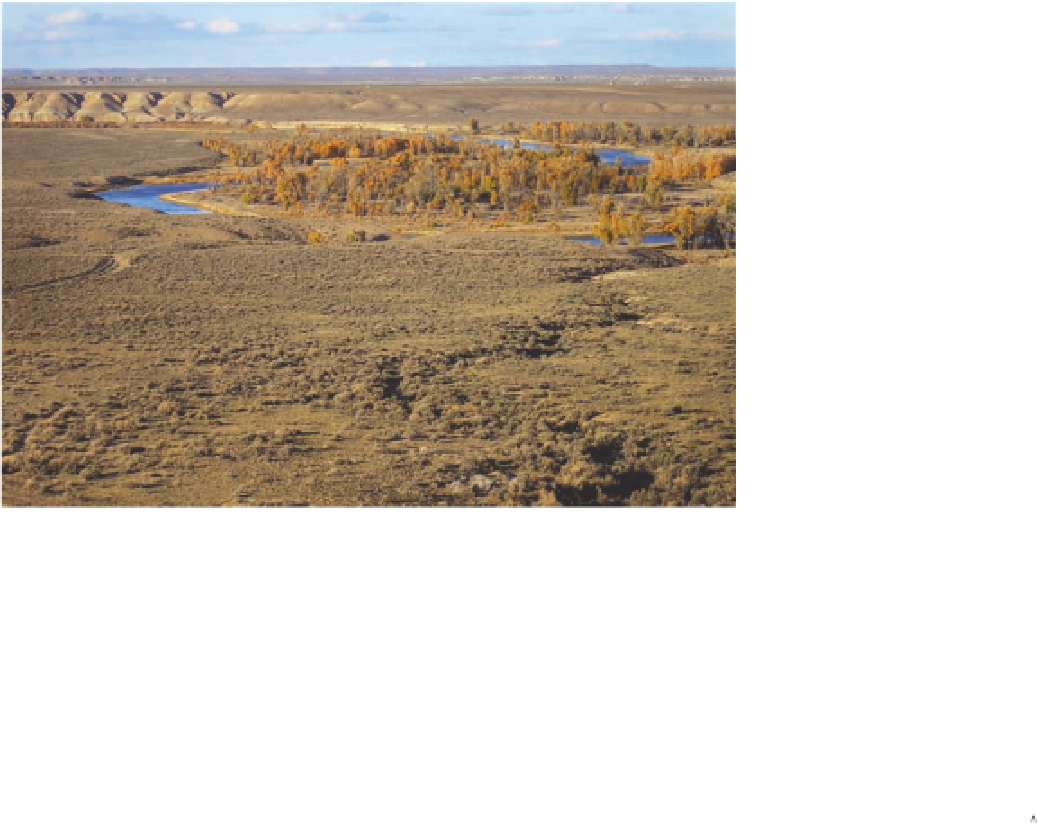Geoscience Reference
In-Depth Information
Fig. 4.4. Rivers and creeks with
dependable streamflow often have
woodlands dominated by two species
of cottonwood. narrowleaf cottonwood
grows in the higher basins, such as here
along the Green River; plains cotton-
wood is more common at lower eleva-
tions on the eastern plains and in the
Bighorn Basin. Wyoming big sagebrush
is taller and more dense in ravines
where snow accumulates, as illustrated
in this photo. elevation 6,200 feet.
big game browsing, and ice damage in the spring. All are
affected by features of the terrain, such as valley width
and orientation, size of the drainage basin, and stream
gradient and sinuosity. Abrupt changes in riparian veg-
etation are typically associated with different riparian
landforms, namely, point bars, channel bars, cut banks,
terraces, and islands (fig. 4.5). Beaver dams, debris jams,
and roads can also have dramatic effects. often, within
short distances, the channel can change from braided to
meandering or incised.
the flatter terrain of some mountain meadows and
the lowlands causes streams to flow more slowly, lead-
ing to the development of alluvial soils over sometimes
broad floodplains. channel meandering is typical at
lower elevations, except where rivers have cut can-
yons or where steeper gradients lead to the formation
of braided streams (see fig. 4.5). Freshly deposited sand
and gravel form bars, which provide excellent sites for
the establishment of some species of willow and, at
lower elevations, cottonwoods and willows. Across from
the point bars are eroding cut banks of the floodplain,
where older trees and other plants eventually fall into
the water (fig. 4.6). cut bank erosion on meandering riv-
ers produces some of the sediments that form new bars
downstream. this natural erosion, along with flooding
and the occasional formation of oxbows, creates a ripar-
ian landscape that is constantly changing.
Above the floodplain are terraces, former flood-
plains that now are well above the river. in western
states, the material in the terraces was commonly
deposited during floods at the time mountain glaciers
were melting, more than 10,000 years ago. At that time
the volume of water was much greater, and it was laden
with sediments that were deposited as
glacial outwash.
Incised
channel
Cut
bank
Floodplain
Bar
Point bar
Channel
boundary
Braided
Meandering
CHANNEL TYPE
Straight
Fig. 4.5. Braided, meandering, and straight channels have
different levels of resistance to changes in channel location,
providing different environments for riparian plants. Bars are
formed by the deposition of gravel, sand, and silt.























Search WWH ::

Custom Search